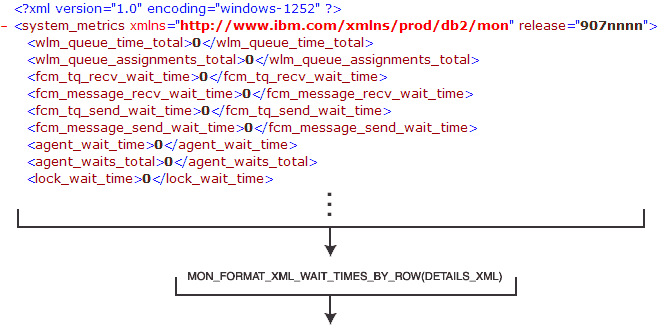You can view the data contained in the XML documents produced by monitor interfaces in several ways, depending on how you want to view or use the data. You can use XQuery to query and manipulate the XML documents returned by monitoring interfaces. You can also use table functions to format the XML documents for easier reading.
XQuery provides a powerful and flexible interface for querying and manipulating XML data. However, there are times where you might want to view element data in a text-based format. Depending on your needs, you can view monitor elements contained in an XML document in column- or row-oriented format. The former is useful if you know which monitor elements you want to see. The latter is useful if you do not know ahead of time which monitor elements you want to examine, such as when you want to see the top five types of wait times. The sections that follow describe two ways that you can view monitor data contained in XML documents as formatted text.
SELECT partition_number,
service_class_id,
statistics_timestamp,
event.rows_returned,
event.total_section_time,
event.total_cpu_time
FROM SCMETRICS_DBSTATS as DBSTATS,
XMLTABLE( XMLNAMESPACES( DEFAULT 'http://www.ibm.com/xmlns/prod/db2/mon' ),
'$metrics/system_metrics' PASSING XMLPARSE( DOCUMENT DBSTATS.METRICS ) as "metrics"
COLUMNS
rows_returned BIGINT PATH 'rows_returned',
total_section_time BIGINT PATH 'total_section_time',
total_cpu_time BIGINT PATH 'total_cpu_time'
) AS EVENT
WHERE service_class_id = 12;The following output shows the results for this query:
PARTITION_NUMBER SERVICE_CLASS_ID STATISTICS_TIMESTAMP ROWS_RETURNED TOTAL_SECTION_TIME TOTAL_CPU_TIME
---------------- ---------------- -------------------------- ---------------- ------------------ ----------------
0 12 2010-01-05-12.14.37.001717 402 990 1531250
0 12 2010-01-05-12.15.00.035409 402 990 1531250
0 12 2010-01-05-12.20.00.021884 412 1064 1609375
0 12 2010-01-05-12.25.00.039175 422 1075 1687500
0 12 2010-01-05-12.29.59.950137 432 1104 1765625
0 12 2010-01-05-12.34.59.948979 442 1130 1796875
0 12 2010-01-05-12.39.59.903928 452 1149 1890625
0 12 2010-01-05-12.44.59.953596 462 1178 1953125
0 12 2010-01-05-12.49.59.970059 473 1207 2062500
0 12 2010-01-05-12.54.59.971990 483 1230 2109375
10 record(s) selected.For more information about using XMLTABLE, refer to the documentation for that function. You can also see examples of using XMLTABLE to view monitor elements in the documentation for the various MON_GET_*_DETAILS functions.

METRIC_NAME TOTAL_TIME_VALUE COUNT PARENT_METRIC_NAME
------------------------------------ -------------------- -------------------- -----------------------------
WLM_QUEUE_TIME_TOTAL 0 0 TOTAL_WAIT_TIME
FCM_TQ_RECV_WAIT_TIME 0 0 FCM_RECV_WAIT_TIME
FCM_MESSAGE_RECV_WAIT_TIME 0 0 FCM_RECV_WAIT_TIME
FCM_TQ_SEND_WAIT_TIME 0 0 FCM_SEND_WAIT_TIME
FCM_MESSAGE_SEND_WAIT_TIME 0 0 FCM_SEND_WAIT_TIME
AGENT_WAIT_TIME 0 0 TOTAL_WAIT_TIME
LOCK_WAIT_TIME 0 0 TOTAL_WAIT_TIME
DIRECT_READ_TIME 0 0 TOTAL_WAIT_TIME
DIRECT_WRITE_TIME 0 0 TOTAL_WAIT_TIME
LOG_BUFFER_WAIT_TIME 0 0 TOTAL_WAIT_TIME
LOG_DISK_WAIT_TIME 0 0 TOTAL_WAIT_TIME
⋮METRIC_NAME VALUE
------------------------- --------------------
WLM_QUEUE_TIME_TOTAL 0
WLM_QUEUE_ASSIGNMENTS_TOT 0
FCM_TQ_RECV_WAIT_TIME 0
FCM_MESSAGE_RECV_WAIT_TIM 0
FCM_TQ_SEND_WAIT_TIME 0
⋮METRIC_NAME TOTAL_TIME_VALUE COUNT PARENT_METRIC_NAME
------------------------------ -------------------- ---------- -----------------------
WLM_QUEUE_TIME_TOTAL 0 0 TOTAL_WAIT_TIME
FCM_TQ_RECV_WAIT_TIME 0 0 FCM_RECV_WAIT_TIME
FCM_MESSAGE_RECV_WAIT_TIME 0 0 FCM_RECV_WAIT_TIME
FCM_TQ_SEND_WAIT_TIME 0 0 FCM_SEND_WAIT_TIME
FCM_MESSAGE_SEND_WAIT_TIME 0 0 FCM_SEND_WAIT_TIME
⋮ SELECT SUBSTR(STATS.WORKLOAD_NAME,1,15) AS WORKLOAD_NAME,
SUBSTR(METRICS.METRIC_NAME,1,30) AS METRIC_NAME,
SUM(METRICS.TOTAL_TIME_VALUE) AS TOTAL_TIME_VALUE
FROM WLSTATS_DBSTATS AS STATS,
TABLE(MON_FORMAT_XML_WAIT_TIMES_BY_ROW(STATS.DETAILS_XML)) AS METRICS
WHERE WORKLOAD_NAME='CLPWORKLOAD' AND (PARENT_METRIC_NAME='TOTAL_WAIT_TIME')
GROUP BY WORKLOAD_NAME,METRIC_NAME
ORDER BY TOTAL_TIME_VALUE DESC
FETCH FIRST 10 ROWS ONLYWORKLOAD_NAME METRIC_NAME TOTAL_TIME_VALUE
--------------- ------------------------------ --------------------
CLPWORKLOAD LOCK_WAIT_TIME 15138541
CLPWORKLOAD DIRECT_READ_TIME 6116231
CLPWORKLOAD POOL_READ_TIME 6079458
CLPWORKLOAD DIRECT_WRITE_TIME 452627
CLPWORKLOAD POOL_WRITE_TIME 386208
CLPWORKLOAD IPC_SEND_WAIT_TIME 283172
CLPWORKLOAD LOG_DISK_WAIT_TIME 103888
CLPWORKLOAD DIAGLOG_WRITE_WAIT_TIME 78198
CLPWORKLOAD IPC_RECV_WAIT_TIME 15612
CLPWORKLOAD TCPIP_SEND_WAIT_TIME 3291
10 record(s) selected.You can use the XMLTABLE function to view any of the elements (including non-metrics elements) contained in the XML document. However, the most frequently used, non-metrics monitor elements are returned as columns by the monitor functions that begin with MON_GET_*, such as MON_GET_UNIT_OF_WORK, or MON_GET_CONNECTION. If you are not familiar with XML, you might find it faster and easier to create queries using these functions than using the XMLTABLE function to extract monitor elements from an XML document.
To summarize: if you are interested in viewing non-metrics monitor elements, the MON_GET_* series of table functions might be a good alternative to the XMLTABLE function. If you are interested in viewing metrics monitor elements, the MON_FORMAT_XML_*_BY_ROW table functions might suit your needs.